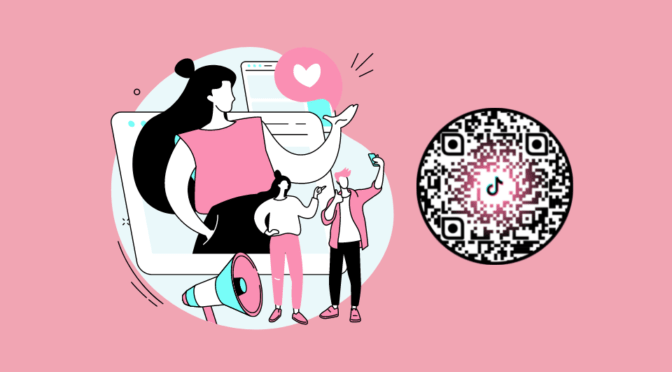QR Codes are a part of our day-to-day digital life, and brand marketers use them extensively to encourage and facilitate interaction with their target audience.
QR Codes have diverse applications, including promoting businesses and products, providing a contactless payment mode, and even driving traffic to a website.
The numero uno factor for QR Codes to gain popularity in all industry verticals is because QR Codes are easier to read – all you need is your smartphone camera. Besides, QR Codes do not need complicated hardware to generate and leverage for various use-cases.
In this article, we will look at 11 different ways in which you can use QR Codes for your business.

1. Allow Users to Download an App Quickly
Marketers can use app download QR Codes to facilitate quick and easy download of their apps from the Play Store and AppStore.
Here are three places you can use to use app download QR Codes for maximum impact and response:
- On business cards. Many business cards include a URL to enable people to download the brand app. However, the link is a weak call to action due to the time taken to type it into a device. Placing an app download QR Code on your digital business card is an instant call to action (CTA) to download the app.
- In emails. QR Codes in email signatures have a high response rate due to this medium’s ubiquity and reach. A QR code with a brief explanation of its utility and benefits is often a powerful CTA.
- Subway billboards and product packaging: QR Codes placed strategically on advertising channels such as posters, billboards, and product packaging make it easy for them to react to an offer and download your app immediately.
Dynamic QR Codes (one code, multiple campaigns) allow businesses to partner for joint promotional campaigns. Another way to leverage QR Codes is by integrating them into your e-commerce strategy. For instance, adding a QR Code on your print materials can direct users to a detailed guide about planning and launching a subscription business, covering critical steps such as product sourcing, pricing, and marketing strategies. An example of a QR code advertising campaign was the joint marketing campaign run by Taco Bell and ESPN for the college football Bowl Championship. It resulted in 225,000 QR code scans and app downloads.
2. Pass on Your Contact Information
We’ve seen how adding a QR Code on a business card is one way to share your business details with your target audience. However, there are many more creative avenues to achieve this.
Make use of vCard QR Codes to help people to get in touch with you by triggering a phone call, an email, or even be redirected to your website.. For example, QR Codes can be embedded on marketing materials or at your stand at an expo or trade show is a quick, simple, and contactless way of disseminating your company information.
Your potential customer can immediately scan the QR code and add your details to their CRM and contact list. The possibilities are endless.
3. Direct Visitors to a Landing Page or Website
QR Codes are frequently used to direct potential customers to a landing page or website. An interested user can scan the code and get directed straight to the relevant landing page or web page.
Businesses can use URL QR Codes to redirect users to their website or landing page to gain traction. Directing the user to your landing page is half the battle won. The other half, of course, depends on the quality of your landing page. Landing page builders can help you in designing a page with a high conversion rate.
Pro tip: Avoid directing users to your homepage if you are seeking high conversion rates. A home page is too generic and will not help in meeting your dedicated goal of conversion. Always direct incoming traffic to a landing or web page that matches your QR code marketing campaign’s intent.
Try a QR Code landing page by Uniqode to make things easier for your visitors.
4. Display a Catalogue or Menu
Printing and distributing product catalogs is a shared sales strategy to promote and sell your products. However, this strategy has some limitations:
- The cost of printing them can burn a big hole in your marketing budget.
- Printing catalogs is environmentally unfriendly.
- They don’t allow you to make updates without expensive and time-consuming reprints.
Instead of printing catalogs, you can add QR codes that take the potential customer to your digital record containing visuals and multimedia content such as product videos and audio files. This catalog is cost-effective, eco-friendly, and easy to update with new products.
Similarly, restaurants and cafes can embed their menus via a QR code menu, which allows the customer to view the menu in a PDF format from their browsers and place an order quickly and efficiently. It amplifies your reach, cuts costs, and saves time. By integrating QR codes into your marketing materials or physical spaces, such as menus or catalogs, you can direct customers to interactive digital platforms or online order forms, which streamlines the shopping or dining experience for enhanced convenience and efficiency.
Pro Tip: Easily convert your PDF catalogs into QR Codes through a PDF QR Code generator.
5. Offer Directions
A location QR Code can be linked to Google Maps, Waze, or even Apple Maps to allow quick and easy access to a location by simply scanning the code.

A location QR code will allow your customers to locate your small business’s address or event with ease without having to look for it manually helps save time.
Pro Tip: You can either use the Google Maps QR Code that allows you to find your location and create a QR Code or copy your location from Waze or Apple Maps and paste it on a QR Code generator to create your QR Code.
6. Access Augmented Reality Features
An Augmented Reality (AR) Code is a QR code with an AR.js marker that directs the user to an AR web or mobile app. AR adds another dimension to your product display and allows for more significant interaction with the user.
Augmented reality superimposes digital content onto the user’s view of the real world. Hence the user’s experience is enhanced with the added layers of visual, tactile, auditory, and olfactory inputs.
QR code marketing campaigns that pivot around augmented reality are gaining popularity and traction. Scanning the AR code allows the user to engage with the product with a richer experience.
7. Share Additional Product Information
QR Codes simplify the process of sharing information with customers. Companies can use these Codes to share additional product information across different media platforms.
Videos: QR Codes are a powerful tool for sharing video content such as announcements of a new product launch, advertisements, and special promotional events. You can upload these videos to social media platforms like Facebook and Instagram and the company’s website. The QR Codes can then direct traffic to the relevant platforms.
Product Packaging: Companies use QR Codes on product packaging to give additional information about their product. For instance, the code on packaged food can allow the customer to access nutritional information or details of the ingredients.
Pro Tip: Make the QR code one of your packaging highlights so that customers see it and are instantly attracted to scan it.
8. Deliver Deals & Offers
We have seen how you can use QR Codes to allow users to quickly and easily download your app onto their device. Once they have the app, QR code Marketing is a quick and efficient way to deliver promotional content such as special deals and offers.

(Source: Costa Coffee on Youtube)
Coffee chain Costa (above) uses QR Codes within its app to allow customers to collect points and redeem them for freebies and discounts in its stores.
You can distribute your promotional Codes or coupons via QR Codes, and your customers can redeem them online or in your store. You can also promote flash sales and add exclusivity and personalization (such as making specific deals only available to users with the app).
You might also like: Top QR Code generator for businesses
9. Get More Reviews
Online reviews are an integral part of brand perception. Online reviews impact purchase decisions for 93% of customers, which applies to B2B and B2C businesses. Further, over half of consumers only trust businesses and products rated four stars or higher.
A company can use QR Codes to seek customer reviews on platforms like Yelp and Google My Business and its website. Ratings and feedback QR Codes are standard and efficient methods of soliciting customer feedback.
Rating QR code: This is a quick and simple way for the customer to leave feedback. The feedback is often emoji-based (happy, sad, or neutral faces or thumbs up/down symbols) with a brief description of their experience. By scanning your code, the customer can complete the feedback process in under 60 seconds.

Feedback QR code: For more in-depth feedback, companies use the feedback QR code. This type of code is based on a star rating (out of 5) and a detailed feedback page to be filled in by the customer.
For instance, management at a hotel would want to know the guest’s overall experience (star rating), along with details on services like check-in, room amenities, and connected services like restaurants and spa.
10. Send a Message or Email
QR Codes can send messages both by text and email. The user can access the message once they have scanned the code. It is a good workaround for SMS messages, which have a character limitation.
Messages sent via QR Codes stay out of the users’ inbox, thereby giving the user 24/7 access to any device’s message. QR Codes are an excellent way to communicate with your SMS and email contact lists, thereby giving your brand greater visibility. This can be particularly powerful when used as part of a social media campaign.
Read more on email QR Codes for interesting business ideas!
11. Provide Custom Content
QR Codes allow you to deliver content customized to individual needs and preferences. Personalization should be an integral part of your content marketing strategy. According to Evergage’s 2019 survey on Trends in Personalization, 80% of businesses saw an increase in customer engagement with personalization. This personalized engagement directly drives customer success by delivering exactly what users need, when they need it.
Personalized content is directed at an individual or group of people based on their needs and preferences. It helps in driving engagement and conversions. You can segment your customers based on factors such as demographics, purchase history, and online behaviors.
To sum up,
QR Codes are a great marketing tool that can help a business market its products and services in innovative and efficient ways. Aside from saving time and effort, they are also a useful metric for measuring your marketing campaigns’ effectiveness and an invaluable source of soliciting customer reviews and feedback. Analytic tools can use the data derived from them for better-informed decision making.
How will you use QR Codes in your marketing campaigns in 2021 and beyond?
Ektha is a QR code expert with years of research and analysis into the evolution of QR codes. Having written over 70 in-depth articles on QR technology, she has developed a comprehensive understanding of how QR codes are transforming industries. Her insights, including The State of QR Report, have been featured in leading publications. With a passion for simplifying complex topics and providing actionable strategies, Ektha helps businesses leverage QR codes to enhance their ‘phygital’ connections.











